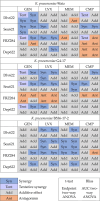Phage-antibiotic combinations against Klebsiella pneumoniae: impact of methodological approaches on effect evaluation
- PMID: 40143863
- PMCID: PMC11937024
- DOI: 10.3389/fmicb.2025.1530819
Phage-antibiotic combinations against Klebsiella pneumoniae: impact of methodological approaches on effect evaluation
Abstract
Background: The combined use of bacteriophages and antibiotics represents a promising strategy for combating multidrug-resistant bacterial pathogens. However, the lack of uniformity in methods for assessing combination effects and experimental protocols has resulted in inconsistent findings across studies. This study aimed to evaluate the effects of interactions between phages and antibiotics on Klebsiella pneumoniae strains using various statistical approaches to formalize combination effects.
Methods: Effects were assessed for four antibiotics from distinct classes (gentamicin, levofloxacin, meropenem, chloramphenicol), three phages from different genera (Dlv622, Seu621, FRZ284), and a depolymerase (Dep622) on three K. pneumoniae strains of the KL23 capsule type. Antibiotics were used at Cmax concentrations, and phages at sublethal levels. A modified t-test, Bliss independence model, two-way ANOVA, and checkerboard assay were employed to evaluate the results.
Results: Among 48 combinations, 33 effects were statistically significant, including 26 cases of synergy and 7 of antagonism. All statistical methods showed consistency in identifying effects; however, the t-test and Bliss method detected a greater number of effects. The strongest synergy was observed with levofloxacin in combination with Seu621 or Dep622 across all bacterial strains. Checkerboard assays confirmed synergy in selected cases but indicated that combined effects could vary with antimicrobial concentrations.
Conclusion: The choice of analytical method substantially impacts the detection of phage-antibiotic effects. The t-test and Bliss method, due to their simplicity and sensitivity, may be optimal for clinical application, while two-way ANOVA for confirming strong interactions. These results emphasize the need to consider interaction characteristics when designing therapeutic strategies.
Keywords: Klebsiella pneumoniae; antagonism; antibiotic; capsule depolymerase; phage; synergy.
Copyright © 2025 Gorodnichev, Krivulia, Kornienko, Abdraimova, Malakhova, Zaychikova, Bespiatykh, Manuvera and Shitikov.
Conflict of interest statement
The authors declare that the research was conducted in the absence of any commercial or financial relationships that could be construed as a potential conflict of interest.
Figures




Similar articles
-
Antibacterial effect of phage cocktails and phage-antibiotic synergy against pathogenic Klebsiella pneumoniae.mSystems. 2024 Sep 17;9(9):e0060724. doi: 10.1128/msystems.00607-24. Epub 2024 Aug 21. mSystems. 2024. PMID: 39166877 Free PMC article.
-
Novel Klebsiella pneumoniae K23-Specific Bacteriophages From Different Families: Similarity of Depolymerases and Their Therapeutic Potential.Front Microbiol. 2021 Aug 9;12:669618. doi: 10.3389/fmicb.2021.669618. eCollection 2021. Front Microbiol. 2021. PMID: 34434173 Free PMC article.
-
Exploring synergistic and antagonistic interactions in phage-antibiotic combinations against ESKAPE pathogens.Microbiol Spectr. 2024 Oct 3;12(10):e0042724. doi: 10.1128/spectrum.00427-24. Epub 2024 Jul 31. Microbiol Spectr. 2024. PMID: 39082827 Free PMC article.
-
Fighting Pathogenic Bacteria on Two Fronts: Phages and Antibiotics as Combined Strategy.Front Cell Infect Microbiol. 2019 Feb 18;9:22. doi: 10.3389/fcimb.2019.00022. eCollection 2019. Front Cell Infect Microbiol. 2019. PMID: 30834237 Free PMC article. Review.
-
Phage-Based Therapy in Combination with Antibiotics: A Promising Alternative against Multidrug-Resistant Gram-Negative Pathogens.Pathogens. 2024 Oct 14;13(10):896. doi: 10.3390/pathogens13100896. Pathogens. 2024. PMID: 39452768 Free PMC article. Review.
Cited by
-
Phage Therapy in Managing Multidrug-Resistant (MDR) Infections in Cancer Therapy: Innovations, Complications, and Future Directions.Pharmaceutics. 2025 Jun 24;17(7):820. doi: 10.3390/pharmaceutics17070820. Pharmaceutics. 2025. PMID: 40733029 Free PMC article. Review.
-
The Current Landscape of Phage-Antibiotic Synergistic (PAS) Interactions.Antibiotics (Basel). 2025 May 27;14(6):545. doi: 10.3390/antibiotics14060545. Antibiotics (Basel). 2025. PMID: 40558135 Free PMC article. Review.
-
Phage (cocktail)-antibiotic synergism: a new frontier in addressing Klebsiella pneumoniae resistance.Front Microbiol. 2025 May 7;16:1588472. doi: 10.3389/fmicb.2025.1588472. eCollection 2025. Front Microbiol. 2025. PMID: 40400679 Free PMC article.
References
-
- Bedi M. S., Verma V., Chhibber S. (2009). Amoxicillin and specific bacteriophage can be used together for eradication of biofilm of Klebsiella pneumoniae B5055. World J. Microbiol. Biotechnol. 25, 1145–1151. doi: 10.1007/s11274-009-9991-8 - DOI
LinkOut - more resources
Full Text Sources

